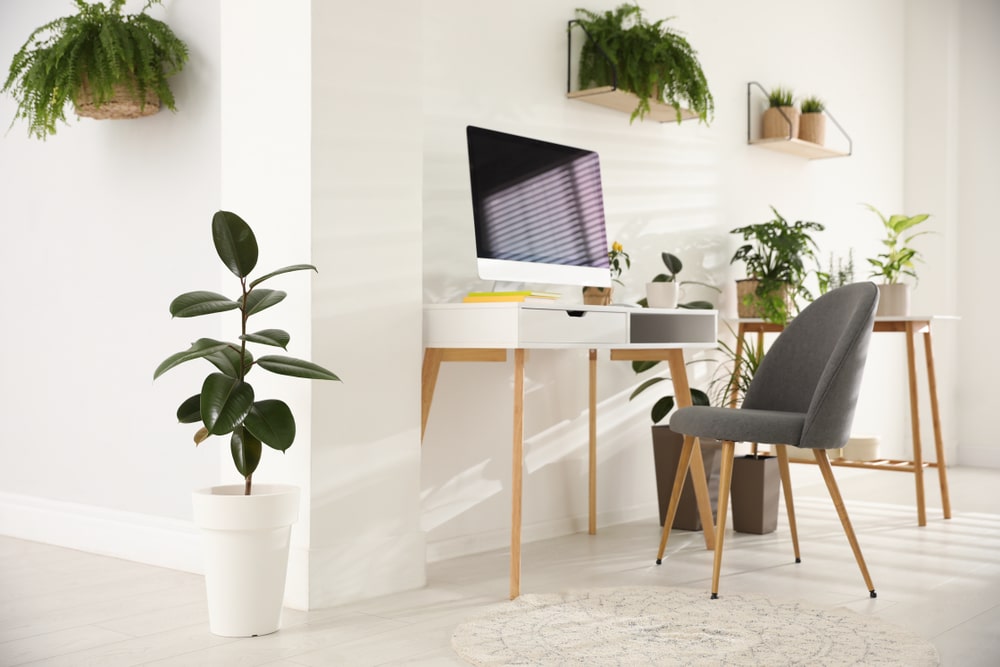Easy Ways to Turn Your Home Office Green
As more people start working from home, it’s become increasingly important to consider the environmental impact of our home offices. Turning your home office green benefits the environment and creates a healthier and more productive workspace.
Why Go Green in Your Home Office?
There are numerous reasons why going green in your home office benefits both the environment and your health. A green office promotes a healthier work environment, marked by improved air quality due to natural light, better ventilation, non-toxic cleaning products, and indoor plants.
Green offices are designed to be energy-efficient and recycle-friendly, which helps conserve energy and reduce pollution. Eco-friendly workplaces have also been linked to enhanced cognitive thinking and higher productivity.
Moreover, adding elements of nature to your workspace, such as plants, can reduce stress, increase productivity, and even decrease sick days. Working from home further reduces the environmental impact by eliminating commutes. Implementing energy-efficient systems and adopting an environmentally-minded culture can eliminate waste and conserve resources.
On top of these health and environmental benefits, going green in your home office can also lead to cost savings. You can significantly reduce energy consumption and lower utility bills by exploiting natural light and using energy-efficient appliances.
Reducing, Reusing, Recycling
Reducing waste is essential to maintaining a green office. Implement a recycling system in your home office for paper, plastic, and electronic waste. Label bins for different types of recyclable materials to make it easy to sort your waste.
Aim to reduce your paper and plastic waste as much as possible. For instance, as a student, think twice before you print something like a research paper conclusion just to show it to your professor. In most cases, a digital version of your paper would suffice. If you must print, use both sides of the paper. Choose products made from recycled materials and avoid single-use plastics.
Reusing items is another effective way to reduce waste. Old jars can serve as storage containers, and scrap paper can be used for notes. Before throwing anything away, consider if it could have a second life.
Choosing Eco-Friendly Furniture
When setting up your green home office, you must make thoughtful decisions about the furniture you use. Opting for sustainable materials is a good starting point. Consider furniture made from bamboo or FSC-certified wood, which are renewable resources and have a lower environmental impact.
In addition to choosing sustainable materials, consider buying second-hand or repurposed furniture. This choice reduces the demand for new production and prevents excellent furniture from ending in landfills. It often adds a unique character to your office space, too.
Energy Efficiency
Energy efficiency is a critical component of a green home office. This involves choosing energy-saving appliances and electronics. Look for ENERGY STAR-rated devices that meet strict efficiency guidelines set by the U.S. Environmental Protection Agency.
Heating and cooling strategies also play a crucial role in energy efficiency. Use programmable thermostats to maintain an optimal temperature in your office without wasting energy. Consider using fans instead of air conditioning whenever possible, and dress appropriately for the weather to reduce dependence on heating.
Natural light is another essential aspect of energy efficiency. It reduces the need for artificial lighting and improves mood and productivity. Position your workspace near windows to take advantage of daylight. When artificial light is necessary, opt for LED bulbs. They use significantly less energy and last longer than traditional incandescent bulbs.
Green Office Supplies
Adopting eco-friendly practices daily is a small yet significant step towards sustainable living. One such practice can be the use of green office supplies.
Choosing eco-friendly stationery and other office supplies reduces your carbon footprint and promotes sustainable manufacturing practices. Look for products that are made from recycled materials or come from sustainable sources.
Refillable pens and markers are an excellent example of this. Instead of throwing away pens, you can refill them once they’re out of ink. This drastically reduces plastic waste. Similarly, numerous options for recycled paper products are available in the market, including notebooks, printing paper, and even business cards.
Indoor Plants for a Healthier Environment
Besides lending a refreshing touch to your workspace, indoor plants are crucial in creating a healthier environment. They act as natural air purifiers by absorbing toxins and releasing oxygen, improving air quality.
Moreover, indoor plants also have a positive impact on mental health. They reduce stress, increase productivity, and enhance mood. Some easy-to-care-for indoor plants include Snake Plants, Pothos, and Spider Plants. These plants require minimal sunlight and watering, making them perfect for indoor settings.
Digitalization
Digitalization has revolutionized the way we work. It’s not only convenient but also environmentally friendly.
Going paperless is one of the most effective ways to achieve this. Using digital notes, cloud storage, and online communication tools significantly reduces the need for physical paper, thereby saving trees. Moreover, these digital tools also enhance efficiency and accessibility.
Reducing e-waste is another critical aspect of digitalization. Instead of replacing electronic equipment every few years, consider maintaining and upgrading them. This not only curbs e-waste but also saves resources and money.
Conclusion
Turning your home office green is a process, but every small step counts. Whether choosing sustainable furniture, reducing waste, or embracing digital tools, each action contributes to a healthier environment for you. Remember, sustainability is a journey, not a destination. Keep learning and improving your efforts to make your home office as green as possible.







